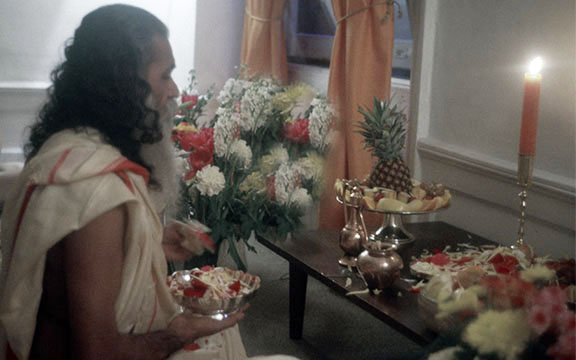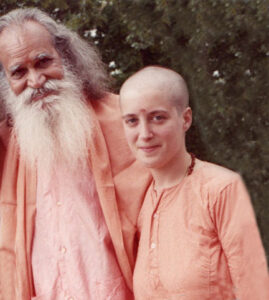
Swami Satchidananda making offerings during puja.
As noted in our last installment (part 3), devotion played a central and foundational part in how Ramu (Swami Satchidananda’s birthname was Ramaswamy, Ramu for short) was raised. In his biography, Sri Swamiji noted that of all the devotional worship offered in his childhood home, the Saraswati puja was the greatest and most special of the household ceremonies. It was held during the last three days of the Navaratri, nine nights worship in honor of the Goddess—God as Divine Mother—in her three main manifestations. She is the moving force behind all the aspects of God.
The first three nights pay homage to the Goddess Kali or Durga, the destroyer. It sounds frightening, yet what she destroys is everything that stands between the devotee and realization of God. After Kali has cleared the way, the Goddess Lakshmi arrives for the next three nights. She is the Goddess of wealth and prosperity. Finally, the Goddess Saraswati appears. As the Goddess of wisdom, she encompasses all learning including the fine arts; and, of course, she is the ruler of all books.
On those days of Saraswati puja, Sri Kalyanasundaram collected all the books from his library. For this worship, the texts were arranged to form a pyramid, steps leading up and down again. A large picture of the Goddess was taken from the wall and positioned so that the book-hill reached her waist. Covering this heap of books were skirts from the temple statues. Ramu’s job was the arrangement of all this and her jewels. Carefully, with painstaking concentration, he glued each golden bracelet, each emerald-studded earring and necklace to the head and arms of the Goddess.
On the ninth night of the festival, the instruments and tools of the house and field were presented for worship since they are the expressions of the power of the Divine Mother. Then all the family joined in the careful disassembly of the pyramid. Since Sri Swamiji established Satchidananda Ashram Yogaville in America, Navaratri has been observed in this same manner every year.
As a child, Ramu shied away from the type of play the children of Chettipalayam engaged in. Instead of “cowboys and Indians,” he played “priest and devotee” with his friends. One child served as the wise Guru; another was the disciple. Their dolls were miniatures of various deities. They constructed temples out of mud and decorated them with leaves and flowers, gathering fruit for a play puja. Ramu’s dreams and visions focused on the deities as well. He favored Lord Subramanya and the Goddess Parvati in particular. As he matured, Ramu’s devotional life, particularly his devotion to the Goddess, became a central theme in his life, which we will explore more in-depth in an upcoming installment of this series.
Throughout Ramu’s childhood, he accompanied his family on trips to visit the swamis in nearby Kaumara Madalayam and to visit Sadhu Swamigal in Palani. And, he also continued to be inspired by the sages and holy people who visited the area. Sri Swamiji’s maternal uncle recalled the following:

Cuddapah Sri Paramahamsa Satchidananda Yogeswara, after spending 200 days in samadhi, 1927.
“When Ramu was about ten years old an incident occurred that has always remained fresh in my mind. Often the men of our village would go to a particular fresh water well to bathe. One day a great Siddhar came to our village. His name was Cuddapah Sri Paramahamsa Satchidananda Yogeswarar, and at the time he was 59 years old. He was the author of the Tamil book Jiva Brahma Aikya Vedanta Rahasyam (“The Oneness of Jiva and Brahma: The Secret of Vedanta;” translated into English in 1925, though out of print currently).”
Interestingly, this text made a significant impact on Sri Swami Sivananda, who, would become the Guru of Swami Satchidananda some 25 years later. In his authorized biography, Swami Sivananda: A Modern Sage, there is the following passage:
“In the hospital, Dr. Kuppuswami [Swami Sivananda’s name prior to Sannyas diksha; he was a medical doctor at this time] had to battle with human pain. Though he healed some, many died before his eyes. Death remained an eternal mystery to him. At this critical point in his life, there came to him an itinerant Sannyasin. Staying with him for a few days, the Sannyasin fell ill, only to be nursed back to health by the doctor. The Sannyasin became captivated by the loving treatment, and presented Kuppuswami with valuable books. One was the Jiva-Brahma Aikya Vedanta Rahasyam by Cuddapah Satchidananda Swami. This was Kuppuswami’s first lesson in Vedanta and the positive aspects of life on the earth plane. The real aim of human life became apparent.”
When Sri Paramahamsa was meditating at the Ekambareeshwar Temple in Kanchipuram, Lord Ekambareeshwar (a form of Lord Siva) came in disguise as an aged saint by the name of Nithyanandar of Vettaveli Paramparai and initiated and taught Yoga to Sri Paramahamsa, renaming him as Sri Paramahamsa Satchidananda Yogeeshwar. He became a master of Yoga, particularly of pranayama. His specialty was something called jalasthambanam—the ability to float on the water in padmasana, the lotus pose, while at the same time singing and giving spiritual discourses. It is said that he meditated and stayed in samadhi for 90 days in 1912, 103 days in 1938, 245 days in 1941, and later 366 days. He entered Mahasamadhi in 1957.
Sri Paramahamsa’s visit to Chettipalayam had captured everyone’s interest and Sri Krishnaswamy Gounder recalled how they attempted to follow in the Siddhar‘s footsteps:

Swami Satchidananda floated in lotus pose well into his 80s.
“One day Ramu’s father, some other villagers, and I went to the well. We all tried to do the same kind of floating and talking but could not. Ramu saw us and wanted to know what we were doing. We told him we were trying out a kind of ‘Yoga floating.’ He laughed and asked why we kept sinking into the water, so we decided to teach him a lesson and challenged him to accomplish this. He was eager to try it out. The minute he entered the water, he began to float and recite poetry. This immediately created a big stir, and soon everyone in the village came to watch him floating easefully in the lotus pose and composing Tamil poetry nearly as well as his father!” Throughout his life, Swami Satchidananda, whenever he would be in any body of water, he enjoyed floating in the same lotus pose he first assumed as a child.
Ramu’s father, Sri Kalyanasundaram, was a poet who was widely known throughout Tamil Nadu for his expertise in composing Chitrabhandanam—the complex construction of poems into visually attractive designs. There seemed to be no end to the intricate designs Kalyanasundaram would make by playing with words. One poem was done in the form of elaborately intertwined snakes; another was a beautifully drawn Sivalingam made by the lines of poetry. There were wheels, complex mandalas, and more. In some compositions every line within the drawing was the same poem. At each point where the lines crossed, the same letter was used.
The illustration here shows how intricately the words intertwined and how skillful a poet needed to be in order to compose beautiful, clever verses while creating such a complex pattern. Ramu would help his father from time to time when just the perfect word escaped him and this, no doubt, led to his love of the poetry of the Tamil bhakti poets, whom he often quoted in his talks years later. The Tamil Sangam, Tamil Nadu’s foremost cultural institution, awarded Sri Kalyanasundaram the title “Chitrakavi”—an honor given to the greatest poets. Later, in the 1950s Sri Swami Sivanandaji gave Kalyanasundaram the title “Kavi Chudamani” (Crest Jewel of Poets).

One of Sri Kalyanasundaram’s poems in the form of a Sivalingam
Find previous installments here: Part 1, Part 2, Part 3
About the Author:
 Swami Premananda, Ph.D. is a senior disciple of Sri Gurudev Swami Satchidananda and served as his personal and traveling assistant for 24 years. Her interest in the study of the spiritual roots of the Integral Yoga tradition and lineage was inspired over many years of traveling with Sri Gurudev to the various sacred sites throughout India that are a part of this tradition. She also undertook a 2-year immersion into the nondual Saiva Yoga Siddhar tradition that is at the heart of Sri Gurudev’s spiritual roots. She further studied the history, sacred texts, and teachings of Tamil Saivism including the Siddhars, bhakti poet saints, as well as the spiritual luminaries who lived in the 19th – 20th centuries and who inspired Sri Gurudev, such as Sri Ramana Maharshi, Swami Ramdas, and Swami Vivekananda. She serves as editor of Integral Yoga Magazine, Integral Yoga Publications; senior archivist for Integral Yoga Archives; and director of the Office of Sri Gurudev and His Legacy.
Swami Premananda, Ph.D. is a senior disciple of Sri Gurudev Swami Satchidananda and served as his personal and traveling assistant for 24 years. Her interest in the study of the spiritual roots of the Integral Yoga tradition and lineage was inspired over many years of traveling with Sri Gurudev to the various sacred sites throughout India that are a part of this tradition. She also undertook a 2-year immersion into the nondual Saiva Yoga Siddhar tradition that is at the heart of Sri Gurudev’s spiritual roots. She further studied the history, sacred texts, and teachings of Tamil Saivism including the Siddhars, bhakti poet saints, as well as the spiritual luminaries who lived in the 19th – 20th centuries and who inspired Sri Gurudev, such as Sri Ramana Maharshi, Swami Ramdas, and Swami Vivekananda. She serves as editor of Integral Yoga Magazine, Integral Yoga Publications; senior archivist for Integral Yoga Archives; and director of the Office of Sri Gurudev and His Legacy.


